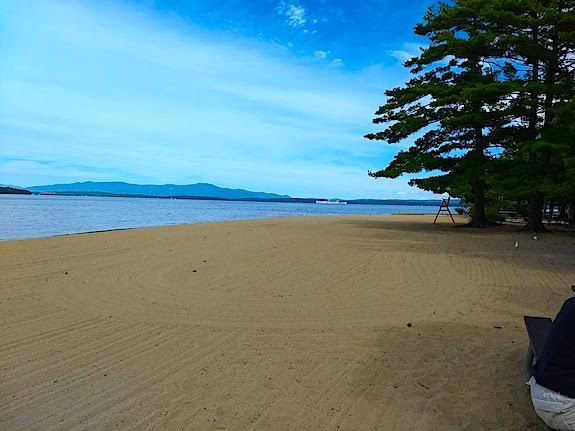
This is the Ellacoya State Park beach where we set up. You’re looking to the north at the Ossipee Mountains. Millions of years ago this massive rock complex was the basement of a giant volcano. Look closely to the left of the distant lifeguard chair and you can see the MS Mt. Washington plying the clear waters of Lake Winnipesaukee. Copyright 2018 Tim Carter
This afternoon I was fortunate to activate Ellacoya State Park in central New Hampshire. I had all sorts of help from Jim Cluett, W1PID and Norman Jackson, K1NAJ. Norman had reached out to me itching to participate with an activation and I was determined to introduce him to the outdoor aspect of Parks on the Air.
Jim had helped me a week before attempt to activate Ahern State Park, but we fell a few contacts short of a valid activation. You need to have ten contacts the same day to qualify for an activation.
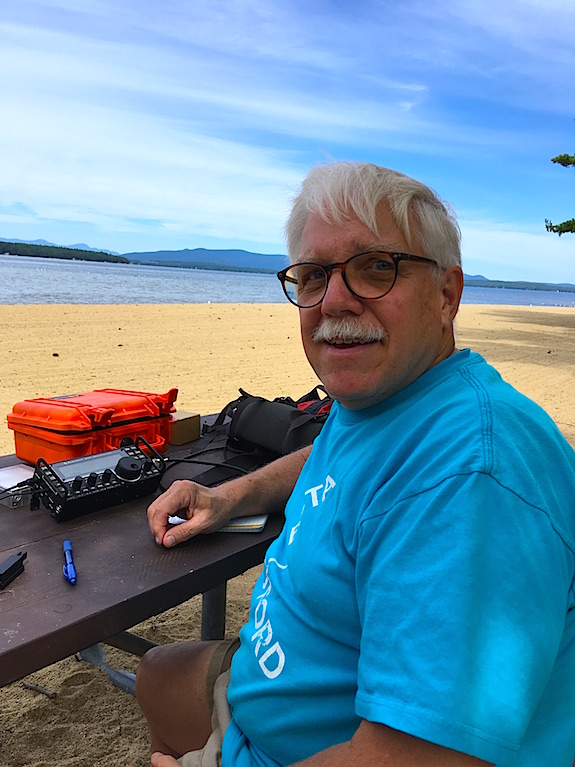
I’m ready to pluck contacts from thin air. The view out across Lake Winnipesaukee was remarkable. Copyright 2018 Jim Cluett
We set up on a picnic table just 30 feet from the lapping waters of Lake Winnipesaukee, the largest lake in New Hampshire. A few other people were there enjoying the delicious sunshine and low humidity. Had we been here just four days prior on Labor Day, we would have had to fight for a table and the beach would have been wall-to-wall people.
The Goal for Ellacoya State Park – Ten Contacts or QSOs
The goal was to have fun, enjoy the jaw-dropping weather, and make ten contacts with other radio operators in that order I might add.
We decided to use my radio gear and I didn’t waste any time throwing my water bottle about 50 feet up in the air over a pine tree branch. The placement worked well as it allowed my 29-foot antenna wire to hang vertically without touching any of the other branches or needles. I was able to get the top of the antenna wire 40 feet up in the air.
Talking to France From the Lifeguard Chair
While I was getting ready to get on the air, Jim decided to set his radio up about 150 feet away. He spied a lifeguard chair and was determined to operate from this perch above the warm sand.
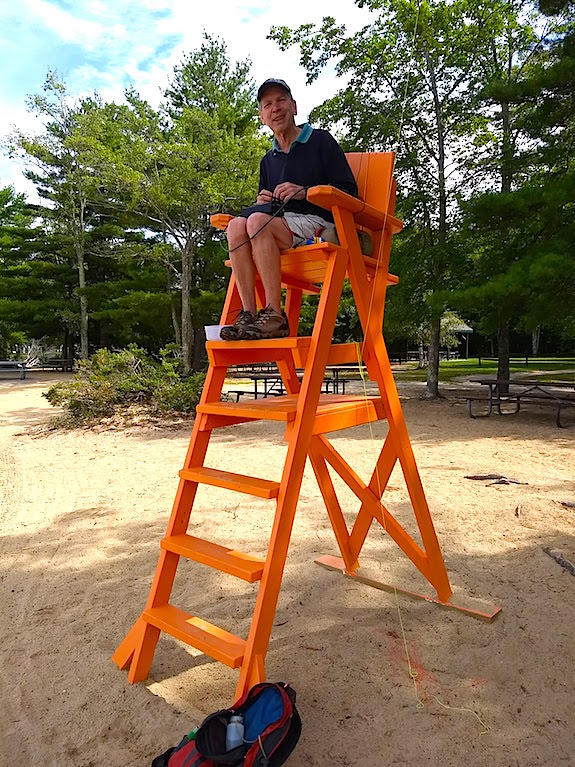
Jim is a clever operator. He’s attracted to anything that’s unique or different. He might be the first person in the world to have made an amateur radio contact while sitting in a lifeguard chair. No doubt he’s the first in New Hampshire. Copyright 2018 Tim Carter
As soon as he turned on his radio, he was able to hear and communicate with his good friend Bert in France, F6HKA.
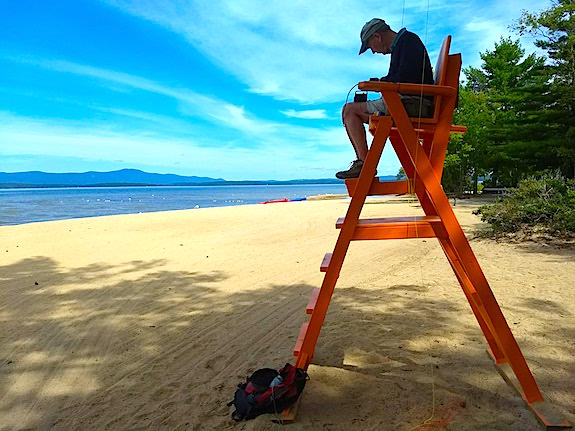
What a view Jim had from his perch! He’s busy setting up getting ready to do Morse code with Bert in France. Copyright 2018 Tim Carter
Patience Pays Off
Once Jim finished his conversation with Bert, I jumped in so I could log my first contact. I needed ten QSOs to qualify as a valid activation. I thought it wouldn’t be a problem and we’d be done in short order. Bert heard me and we had a brief conversation at 12:50 pm.
The other nine contacts were clawed from the ether with lots of patience. Here’s my log:
CALL SIGN TIME FREQUENCY SIGNAL REPORT
| F6HKA | 1650 UTC | 14.051 | 339 |
| K3RTV | 1750 UTC | 7.057 | 559 |
| KB3WAV | 1800 UTC | 7.049 | 599 |
| W2QE | 1810 UTC | 7.027 | 569 |
| N2AK | 1822 UTC | 7.026 | 549 |
| W3JRR | 1826 UTC | 7.049 | 579 |
| KN4ZQ | 1832 UTC | 7.034 | 579 |
| W1PID | 1847 UTC | 7.030 | 599 |
| K1NAJ | 1849 UTC | 7.030 | 599 |
| N4CQD | 1915 UTC | 14.030 | 559 |
Look at the times and you’ll see it took quite a while to get the ten contacts.
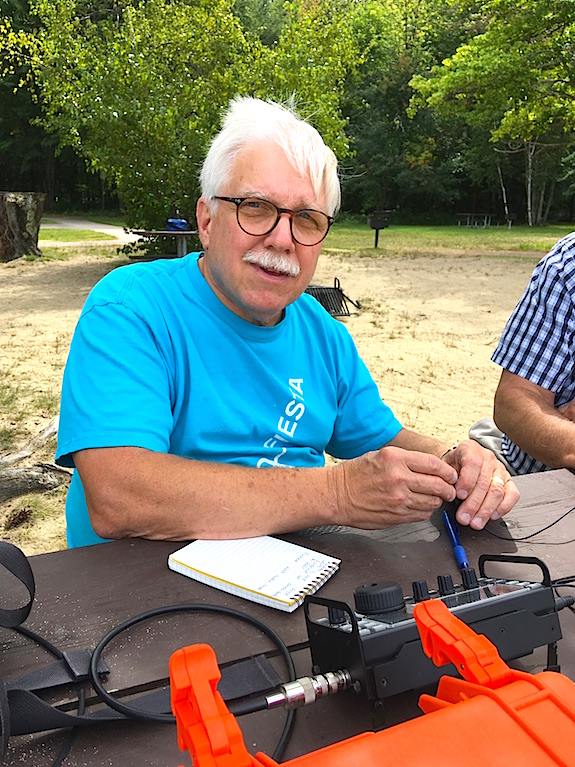
Here I am trying to get ten contacts as fast as possible. It took over two hours! Norman is sitting to my left. Copyright 2018 Jim Cluett
Rare Signal Report Opportunity
About halfway through the activation we heard a conversation happening between two operators and one of them had an issue with his equipment. His signal sounded like a buzzing bee. Listen for yourself:
We tried to contact him, but he didn’t hear us. It would have been a rare opportunity to send back a signal report like 593 as there’s no way he deserves a 9 for the tone part of the RST.
Ducks and Gulls at Ellacoya State Park
A few other people were enjoying the late summer day, but we were all outnumbered by tame ducks and aggressive seagulls that had been spoiled all summer long getting food handouts from many people who visited this wonderful state park.
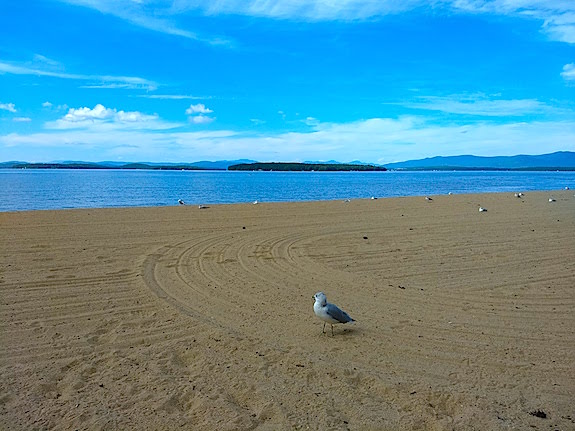
Seagulls are brave and fierce. They’ll steal your food or other things. Don’t turn your back on these creatures. Copyright 2018 Tim Carter
The gulls would steal food from the ducks and squawk raising quite the racket. My guess is there were just under 100 gulls resting on the beach and perhaps ten ducks.
Jim, Norman and I had a marvelous time and this beach is a great place to spend a warm late spring, summer, or fall day. I don’t recommend coming here to do radio in July unless you want a beach ball bouncing on your radio or knocking your antenna out of a tree!

Thanks Tim and Jim for a great day in the outdoors. Anytime either one of you are a going to launch out again, just let me know! How is that for a self-invite!. Meanwhile I am working on my “paddle” skills!~!
Here’s the counterproposal. Next time you want to go out, you provide your 817, battery key/paddle and I’ll put up the antenna and supply the coax. You become the control operator. If I want to operate, I’ll go set up away like Jim did in the chair or plug in my paddles to the 817 if it has a built-in electronic keyer for iambic paddles.
Sorry I missed you, Tim. I was listening but didn’t hear much of anything on the bands. Glad you guys had a good time.
72, Craig WB3GCK
TNX Craig,
We heard maybe six more stations than what you see in the above log, but they didn’t hear us. Look how long it took for ten Qs!
Back in 2016 during NPOTA, you and I would have had those in 15-20 minutes!
TNX for reading the story.
Nice write-up. Glad you were able to make 10+ Q’s.
Hint, if you’re able to be out at 1900Z Wednesdays, you’ll find several hundred CW ops on 20 and 40 meters during the CWOps CWT mini contest. The exchange is fast. I try to be at a Park every possible Wednesday if no medical appointment or family obligation interferes (and I try to NOT Schedule on Wednesday afternoon).
I typically make 15 to 30 contacts in the hour of the CWT, and if I arrive early, I’ll make 5 to 10 before 1900Z.
72/73 de n8xx Hg
Hank,
That’s great advice. Jim has said the same thing. My plan in the future for all these POTA activations is to do them on contest weekends or during the week when there’s a sprint as you describe. The POTA chasers, in my opinion, are only about 10 to 15 percent of how many there were for the 2016 NPOTA event.
I tried calling CQ POTA for ten minutes at the front end of the activation and not one person came back. Back two years ago, I’d have had a mini pileup in the first few minutes that grew and grew as others spotted me.
I do enjoy more getting out to scenic locations, but it’s also nice to get the minimum ten Qs!
Tim, enjoyed your story. Chuckling while remembering your water bottle flings at the base of Mt. Washington the night before the bike race.
I thought we nailed it going over that tree that night? Didn’t my first throw work? Maybe not. I do remember I did a demo throw for someone who missed seeing it go up earlier. I nailed this throw first time down at Ellacoya. I normally don’t put the halyard up in pine trees for any number of reasons, but this was our only choice. It worked quite well because of the position of the branches.